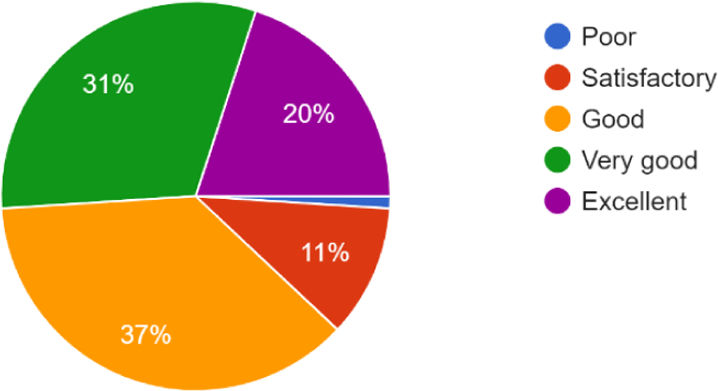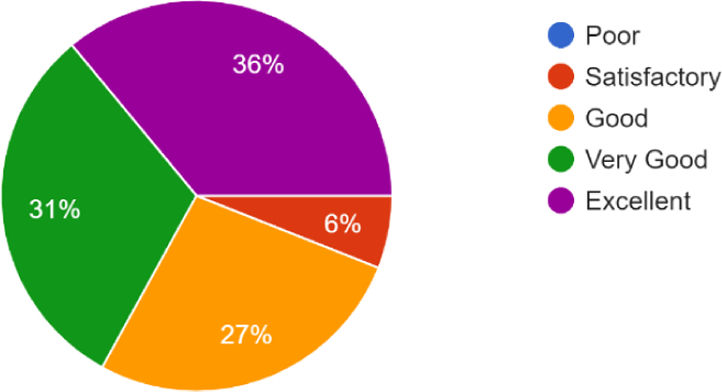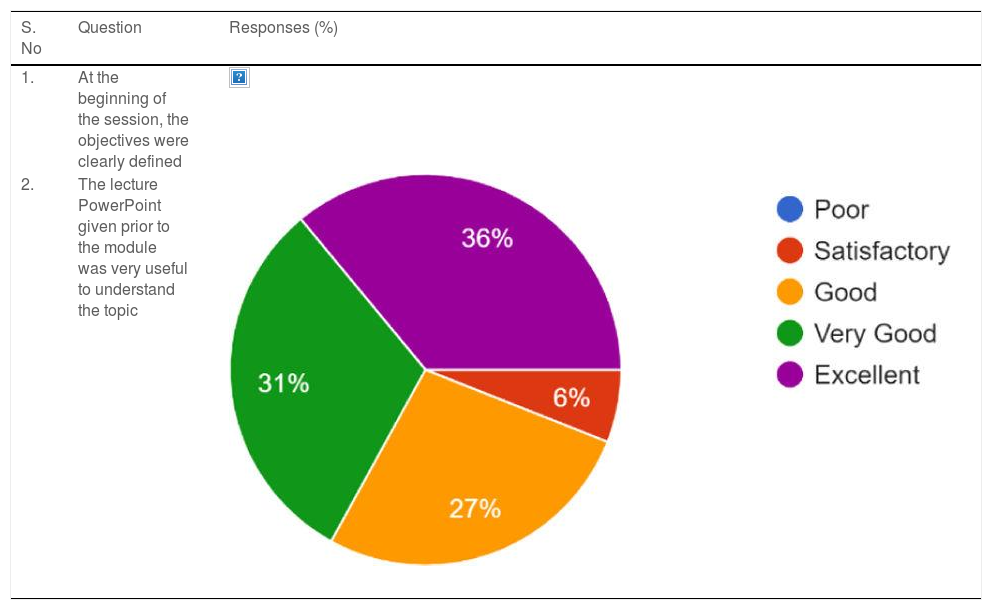Flipped Classroom is a blended form of learning in which the traditional didactic lectures are replaced by active classroom learning experience. Flipping the lectures outside the classroom and using the classroom for active interaction and projects has been the need of the hour. It is an innovative way of learning anatomy.
MethodsThe study was done at Department of Anatomy, ESIC Medical College, KK Nagar, Chennai. After obtaining ethical committee approval and Consent for participating in the study, Pre-test questionnaire was shared through Google forms. The lecture PowerPoint about anatomy of larynx was shared with the students. Next day, during the scheduled class, the students were asked to present anatomy of larynx using different types of models. Post-test questionnaires were also shared, and the students were asked to submit feedback forms at the end of the session. The students were assessed by a group of subject experts who assessed the student’s anatomical knowledge, innovation with which they prepared the model, presentation, correctness of presentation and clinical application.
ResultsOut of the 126 first year MBBS undergraduates, 100 students actively participated in the study. 41% of students agreed and 47% of students strongly agreed that flipped classroom was an enjoyable way of learning. 51% of students strongly agreed that they were able to go through the lecture prior to the presentation.
ConclusionsFlipped classroom enhanced student learning through knowledge applications. Flipped classroom helped teachers to review and understand how much their students have read, retained, and applied the knowledge which was catered to them. There was largely a positive response for flipped classroom though flipped classroom cannot replace a regular classroom. Flipped classroom can be cumbersome as it involves extensive planning and coordination. It can be used to promote interest in the subject. Flipped classroom enhanced peer assisted learning.
El Flipped Classroom es una forma mixta de aprendizaje en la que las clases didácticas tradicionales se sustituyen por una experiencia de aprendizaje activo en el aula. La necesidad de trasladar las clases fuera del aula y utilizar el aula para la interacción activa y los proyectos ha sido la necesidad del momento. Es una forma innovadora de aprender anatomía.
MétodosEl estudio se llevó a cabo en el Departamento de Anatomía, ESIC Medical College, KK Nagar, Chennai. Después de obtener la aprobación del comité ético y el consentimiento para participar en el estudio, se compartió el cuestionario previo a la prueba a través del formulario de Google. Se compartió con los estudiantes el PowerPoint de la conferencia sobre la anatomía de la laringe. Al día siguiente, durante la clase programada, se pidió a los estudiantes que presentaran la anatomía de la laringe utilizando diferentes tipos de modelos. También se compartieron los cuestionarios posteriores a la prueba y se pidió a los alumnos que presentaran formularios de opinión al final de la sesión. Los alumnos fueron evaluados por un grupo de expertos en la materia que valoraron los conocimientos anatómicos del alumno, la innovación con la que prepararon el modelo, la presentación, la corrección de la exposición y la aplicación clínica.
ResultadosDe los 126 estudiantes de primer año de la MBBS, 100 alumnos participaron activamente en el estudio. El 41% de los estudiantes estaba de acuerdo y el 47% estaba muy de acuerdo en que el flipped classroom era una forma agradable de aprender. El 51% de los estudiantes estuvo muy de acuerdo en que pudieron repasar la clase antes de la presentación.
ConclusionesEl flipped classroom mejoró el aprendizaje de los estudiantes mediante la aplicación de conocimientos. El flipped classroom ayudó a los profesores a revisar y comprender cuánto han leído, retenido y aplicado sus alumnos los conocimientos que les fueron impartidos. La respuesta a la flipped classroom fue mayoritariamente positiva, aunque la flipped classroom no puede sustituir a una clase normal. La clase invertida puede ser engorrosa, ya que implica una amplia planificación y coordinación. Puede utilizarse para fomentar el interés por la asignatura. La clase invertida mejora el aprendizaje asistido por los compañeros.
Among the various available teaching learning methods for the medical students, the largest proportion is contributed by the didactic method. The didactic method is characterized by lecture or teaching session by an expert to a group of learners. Any prospect for questioning or clearing any doubts regarding the taught topic is usually restricted to closing moments of the session as the learner is occupied with the task of recording the session or making notes of the same.1
For enhancing the active participation of the students, a newer approach known as flipped classroom or inverted classroom was brought into teaching-learning curriculum. In flipped classroom, the teaching material is provided to the students before the scheduled teaching session and the students are asked to report back with preparation of charts, models, power-point presentation or any other mode for describing the topic. This is followed by formative assessment, questionnaire session, group discussion or presenting the topic to selected group of experts or single teacher.2 The respective roles are reversed as the learner must prepare and present the selected topic to the teacher, simultaneously learning and making others to understand the topic including the expert. Thus, from being the ‘sage on the stage’, the role of teacher has been shifted to the ‘guide by the side’.3 The students for whom the flipped classroom approach was used were more active and involved in the learning process with more awareness about their own learning process.4
During the current scenarios of Covid-19 pandemic it becomes rather more important to continuously keep evolving in terms of teaching – learning methods to increase the receptiveness among the students and develop innovative ways to understand important topics which becomes boring and difficult to understand otherwise in absence of normal physical demonstration classes. The aim of this study was to understand the student’s perspective in the Indian context. This study will bring out honest expression of students regarding flipping the classroom.
The current study focuses on more active participation from the students and checking their higher cognition and how much they have understood the particular topic. It is a kind of modified flipped classroom.
In the older method of teaching, the teacher used to deliver the knowledge in the form of lecture or demonstration and the pupil or student had to reproduce the same at the time of examination without any out of the box thinking about the same. This “Transmittal model” considered pupil’s brain as an empty pitcher which required filling by the teacher.3 The passive outdated models of teaching made ways for newer methods which require active participation of the learner since the learning is dependent on two-way communication between students and the teacher. The newer models consisted of different learning plans which were skill-driven, behavior-driver, attitude-driven or competency-driven and consisted of technology and non-technology-based methods.5,6
Materials and methodsThis research was carried out in the Department of Anatomy, ESIC Medical College and PGIMSR, KK Nagar, Chennai on 100 volunteer students who actively took part in Flipped classroom. The student volunteers were from the first-year medical school in 2020-21 academic year. Ethical committee approval was obtained before conducting the study (IEC No. IEC/2021/1/28).
Concept developmentTo break the monotony of online lectures and to create interest in learning anatomy, we had planned for a flipped classroom on the anatomy of Larynx. The students were asked to submit an informed consent through Google forms. Those students who consented for the study were shared a PowerPoint on the Larynx. Students were asked to learn about the Larynx anatomy and make a model of the Larynx. The students could choose their mode for making the model either through clay or foam sheets or PowerPoint or chart. Then the next day during class they were asked to present the model. This was to be assessed by a group of subject experts. The subject experts divided the students into batches and assessed each student according to anatomical knowledge, innovation with which they have done the model, presentation, correctness of presentation and clinical application. This could help in testing higher level of cognition according to Bloom’s taxonomy.
Before presenting the model, the student volunteers had to take a pretest through Google forms. After presenting also, the students had to take a post-test through Google Forms. Students had to submit a feedback form also.
Data collectionPre-test and post-test question had same questions about the anatomy of Larynx. There were 9 questions on the anatomy of larynx and its clinical application. Feedback form had 9 questions prepared by the authors. Likert type questions were asked in the Feedback. Responses were accepted through Google forms. There was an open-ended question on the reflections of the flipped classroom (how they felt). The data was password protected and stored in digital format.
Data analysisThe Data Analysis was done on Microsoft Excel after exporting the data from Google Forms. Mean Pre-test and posttest marks were calculated. Then Spearman’s rank correlation coefficient was calculated. Though we could not compare the marks of students with the previous offline batch.
ResultsIn this present study, Students gave positive feedback for flipped classroom.
The feedback of students is tabulated below in Table 1 and Table 2.
Student perspective on flipped classroom.
| S. No. | Questions | Responses (%) |
|---|---|---|
| 1. | The method was more engaging and interactive compared to traditional classroom | |
| 2. | The module provided sufficient knowledge and deeper understanding | |
| 3. | Many more modules should be organized in future | |
| 4. | The method made me actively participate with the subject | |
| 5. | Enjoyable way of learning | |
| 6. | The activity enabled me to go through the topic prior to the module |
36% of the students felt that flipped classroom was more engaging and interactive compared to the traditional classroom. 29% of students strongly agreed that the module provided sufficient knowledge and deeper understanding of the subject. 49% agreed and 24% strongly agreed that they needed more modules.
The mean pretest score was 10.2.
The mean posttest score was 10.57.
Spearman’s correlation coefficient was positive (Fig. 1).
Fig. 2 shows some models of larynx made by students.
Few answers to the open-ended question on thoughts and reflectionsMost student took responsibility of their learning and commented that flipped classroom was innovative and created interest what they were about to learn. It was more engaging and helped to learn concepts better.
DiscussionFlipping the classroom is a way of blended learning introduced by Bergmann and Sams in 2014 to enrich the teaching learning culture in studying Mathematics. Now Flipped classroom has gained importance in science, arts and health and has been used as a successful instructional strategy for health sciences. It has enhanced problem based learning and team based learning.7
Several studies have been done to understand the effectiveness of flipped classroom among students. Flipped classroom has a high student satisfaction and helped students improve their academics. Attendance to this program was more than 95%. The paradigm shift of the role of teacher from sage on stage to guide by side made the student more active learners.8–10 For designing the flipped classroom model, the learning goals should be identified based on various desired competencies, followed by multiple form of assessment. Different models of flipping the classroom designated by the number of students involved, number of competencies covered, and the mode of assessment used for the same. Collaborative learning consists of small groups of students work together toward a common competency.
Flipped classroom fosters creativityVisualization enhances Creativity according to Martin and Schwartz.11 They emphasized that the learners should visualize first, then the they should have a predilection for creating their visualization.
Creativity is a higher order thinking skill in Bloom’s taxonomy. It is a mental process which involves the generation of new ideas, concepts or associations between existing ideas or concepts.12 Creativity paves the way for Novelty. Novelty is defined as the sense to capture the idea which is not well worn and which is something new.11 We in our study implemented a new form of in class activity which has not been previously described. The students were sent a powerpoint on the anatomy of Larynx and asked to make a model of Larynx. They were also asked to present it in class to the facilitators who checked on the correctness of the knowledge acquired. The other characteristics of creativity are flexibility and fluency. The students were allowed to present their ideas in form of models, charts or powerpoint which enabled us to check the flexibility and the students presented in front of the facilitators which enabled us to check fluency. So, our work is a novel and creative form of flipped classroom which included all the three characteristics of Creativity.
Challenges, advantages and limitationsThe main challenges that students faced were it required more time and more work and limited preparation time. Even though, the preparation time was less, there was enthusiastic participation and active learning of students. The challenges faced by facilitators was that it required more time and more workload.
The advantages of flipped classroom as observed in this study was that this mode of teaching enhances self-directed learning skills, and also analytical and interpretation skills in solving problem based questions as effect of unilateral/ bilateral recurrent nerve palsy and effective resynthesis. Problem based learning described by introduction of a problem in beginning of the session and different methods to solve the problem are asked. Team based learning is characterized by conducting multiple small groups in single classroom. The small groups are helped by the teacher for articulating their thought during intragroup or intergroup discussion.7
Also Flipped classroom fosters healthy competition with peer assisted learning in making models leading to a holistic approach of learning.
ConclusionFlipped classroom is a creative, innovative and fun way of learning. There has always been a positive response from students for Flipped classroom. So, our recommendation is to introduce flipped classroom in at least 10% of lectures under the Competency Based Medical Education curriculum in India. The noted limitations were (i) time consuming, (ii) need of a lot of effort, (iii) shortage of hands and (iv) necessity for technology training for the teachers. The minute details in anatomy had to be reinforced by small group teaching for a better outcome. This study emphasizes the need for creativity in implementing flipped classroom which will improve student’s behaviour towards learning.
Author contributionConceptualization- PJ, Data collection- PJ, RP, First draft- PJ, RP, Critical Review- MA, AR, AK.
Source of fundingThere was no funding obtained for this project.
Statements and declarationsThis study was done after obtaining IEC approval from IEC, ESIC Medical College and PGIMSR. Informed consent was obtained from all participants before participating in the study.
Funding informationThere was no funding obtained for this project.
The authors declare that there is no conflict of interest.
We extend our sincere thanks to our dear students who consented and actively participated in the study.






























